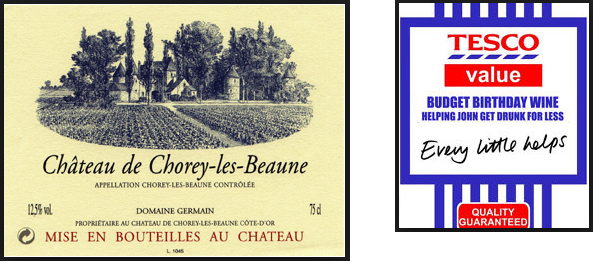I really like this very simple post about how to buy wine, when you don’t really know much about it (which is definitely me). Basically, select a price (say, £7.95), then select a wine at that price. That’s kind of it. And what Evan Davis is saying is “Statistically, give or take anomalies, most wines at £7.95 will be about £7.95-ness in quality”. The article is written from the consumers’ perspective but if you view it from the vendors’ point-of-view, he’s saying “If you want to charge £7.95 for your wine, you’d better make it worth around £7.95 in value”.
Though this is a massive over-simplification of the process of coming up with a product, researching that product, marketing it, selling it effectively etc etc, it is, for me, a fundamental approach to product marketing. If you want to add 50% to your bottom line, then, somehow, you need to be adding 50% more value to customers this year compared to last year.
I’ve written previously about the difference between big-M Marketing and little-m marketing – the difference between finding new markets, new people, researching what people want, creating propositions etc and the less impactful role of just tweaking Adwords, designing flyers and so on. I think the two most effective bits of work that a Product Marketing person can do, under the banner of “Big-M Marketing” are:
- Finding whole new markets and groups of people who could use your proposition in some way. I.e. you’re currently selling wine in the UK for £7.95, why not sell wine in Ireland for 10 Euros?
- Finding new ways to add real value – researching what people actually want and either coming up with new products, or adjustments to a product that people want. Really, providing something of tangible value.
An example of the latter is lower-alcohol wine mixers. There’s a large section in Sainsburys selling pre-mixed Buck’s Fizz, Kir Royale, Bellini and so on which barely existed 5 years ago.
Some bright spark has thought “Hang on, rather than forcing someone to find a cheap Cava then try and find where on Earth the cassis is displayed, let’s just mix them and sell them at a great price!”. It’s clever – if somebody has to drive, but doesn’t just want to drink orange juice, they’re very low alcohol and great too.
If you were a wine vendor, and a marketing person in your org came up with that idea, there’s a pretty good chance you could increase your revenue by a reasonable margin that year (assuming you get everything else right!). Particularly if you were already selling all of your current wines in the right places, with the best labels, at the right price, in the right combinations (if relevant).
Of course another way the wine company could make more revenue is to improve the wines they currently offer. Obviously, easier said than done, but if they can come up with the processes and methods to improve the grapes (I suspect “Having better hillsides in France” might be part of it) and the wine thereafter, they’re directly improving the value of what they offer – and therefore, by Evan’s simple economics, can charge more for their wine. NB: I don’t think much market research is needed here – I can say pretty confidently that a better tasting wine is what most customers are looking for..
This doesn’t mean, of course, that there isn’t revenue to be obtained from great presentation and promotion. If both of the following labels were on £7.95 wines, which are you most likely to buy:
And of course there are countless examples of great marketing adding enormous wealth to a company’s coffers. The one that comes to find is Calvin Klein underwear. Add your brand name to a pair of pants and watch your business soar! And there are lots more examples like this where, fundamentally, the product offering hasn’t been improved at all (were the pants really any better for Klein putting his name on them?) and the marketing push has had an amazing impact.
But – I think this sort of success is just far less predictable than success borne of product improvements. These are shots in the dark and for every Tango Orange ad, there are a string of forgotten, and often very expensive marketing failures. Also, I’ve rarely seen examples where just re-arranging product combinations or thinking of some clever re-presentation of the core value has made any sort of lasting impact.
In contrast, I believe adding new, researched features to your product offering is the most predictable way of increasing revenue. I.e. by adding value to your offering, you can charge more for it and make more money. Simple! Joel Spolsky said this a long time ago:
With six years of experience running my own software company I can tell you that nothing we have ever done at Fog Creek has increased our revenue more than releasing a new version with more features. Nothing. The flow to our bottom line from new versions with new features is absolutely undeniable.So if you have a choice between spending £100,000 on finding and implementing great new features for your products, or spending that on a new advertising campaign, though the ad campaign may produce some magic like it did for Tango, the more predictable revenue will come, I think, from adding some real value for your customers.

